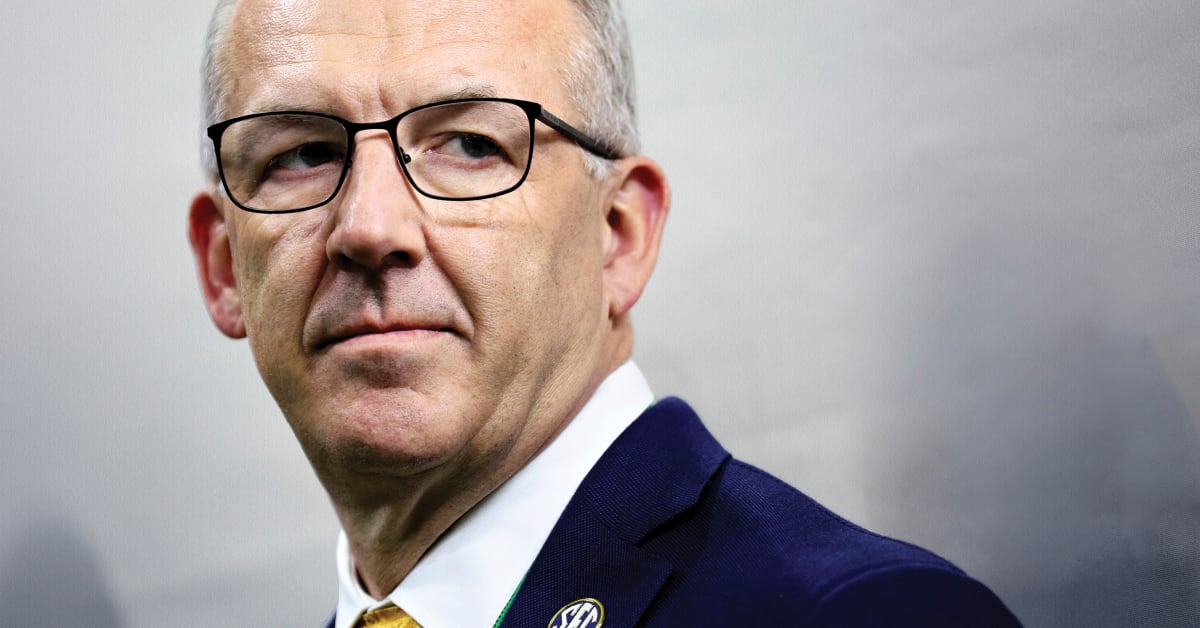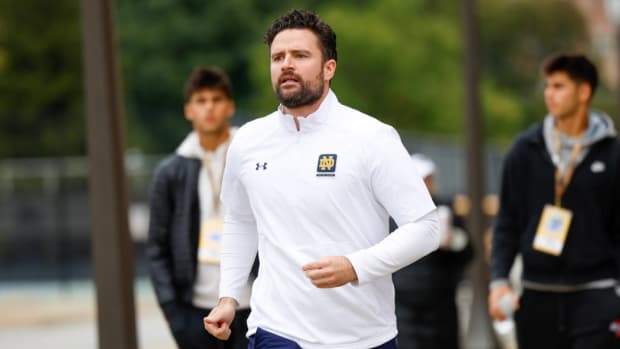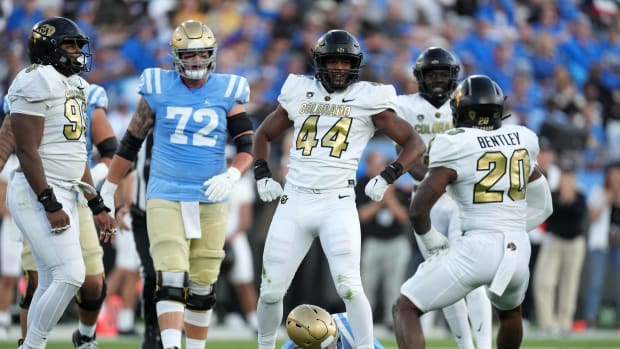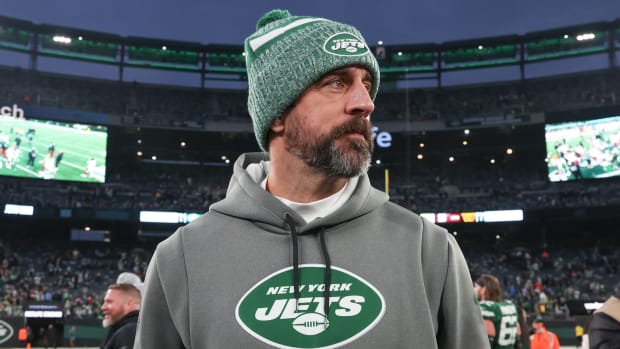Greg Sankey has a big brain and a wonk’s zeal for esoteric and complicated issues. Few people in college athletics are more at home amid the weeds of NCAA bylaws and policy, which is a big reason why he’s been the co-chair of the association’s massive undertaking to remake itself over the past year. When the work gets dense and administrators’ eyes glaze over, Sankey’s light up.
The commissioner of the Southeastern Conference projects an Ivy League intellect and a patrician air. But Sankey’s path to becoming the most powerful figure in college sports winds through neither a privileged upbringing nor an elite education. Quite the opposite, in fact.
Yankee accent aside, he’s got more in common with rank-and-file SEC fans than anyone might have guessed.
The son of a welder spent some of his formative years living in a mobile home in upstate New York near Skaneateles Lake (“Long Lake” in one of the local Iroquois languages). One summer, the Sankey family lived in a garage that lacked air conditioning. The Finger Lakes region outside Syracuse is a resort area for many affluent New Yorkers, but the everyday reality of living there was nothing glamorous for Sankey.
He was the first member of his family to go to college. His education meandered through an obscure NAIA school in Texas, a New York junior college, SUNY Cortland (where he earned an undergraduate degree in education) and Syracuse (master’s degree in education). He was a backup catcher at LeTourneau in Longview, Texas, then played basketball at Cayuga Community College.
From there, Sankey authored a prodigious rise through the college sports ranks. He’s evolved from intramural director to golf coach to campus compliance director to low-major conference commissioner to Mike Slive’s right-hand man to replacing Slive. Known to never raise his voice, he’s brought a measured calm to a conference that is anything but. In his current role, he has carried on the twin legacies of recent SEC commissioners: continuing conference expansion and altering the football postseason. As the Power 5 leadership ranks have turned over and the NCAA’s central authority has waned, he’s become the most authoritative person in the industry.
Greg Sankey, now 58, has driven himself a long way. A lifetime of decisions, some of them difficult, led him away from upstate New York and culminated in commissionership of the most successful athletic conference in the nation. Since then, he has evolved into the most powerful person in his line of work, at a moment of acute fragility within the enterprise. But as his league swells in numbers, lines its coffers with cash and helps destabilize the national landscape, it’s fair to ask: Is the smartest guy in every room and on every committee now piloting college sports along the best path, or the road to ruin?
The almost willful blandness Greg Sankey brings to a podium cloaks an intensity that simmers within. Former Mississippi chancellor Daniel Jones once described Sankey as “anti-charismatic” to The New York Times. “That hurt my feelings,” the commissioner jokes—but it fits. To a point.
Sankey can be boring on the outside but burning with ambition and competitiveness on the inside. In that way, an intellectual upstate New Yorker is a perfect fit with the fiercest conference in college sports. He was a two-sport college athlete, albeit at two different schools. The journey away from a mobile-home upbringing began by going to play baseball in Texas, drawn by the engineering program and religious affiliation at LeTourneau. “I was looking for adventure,” he says. “An opportunity to spread my wings.”
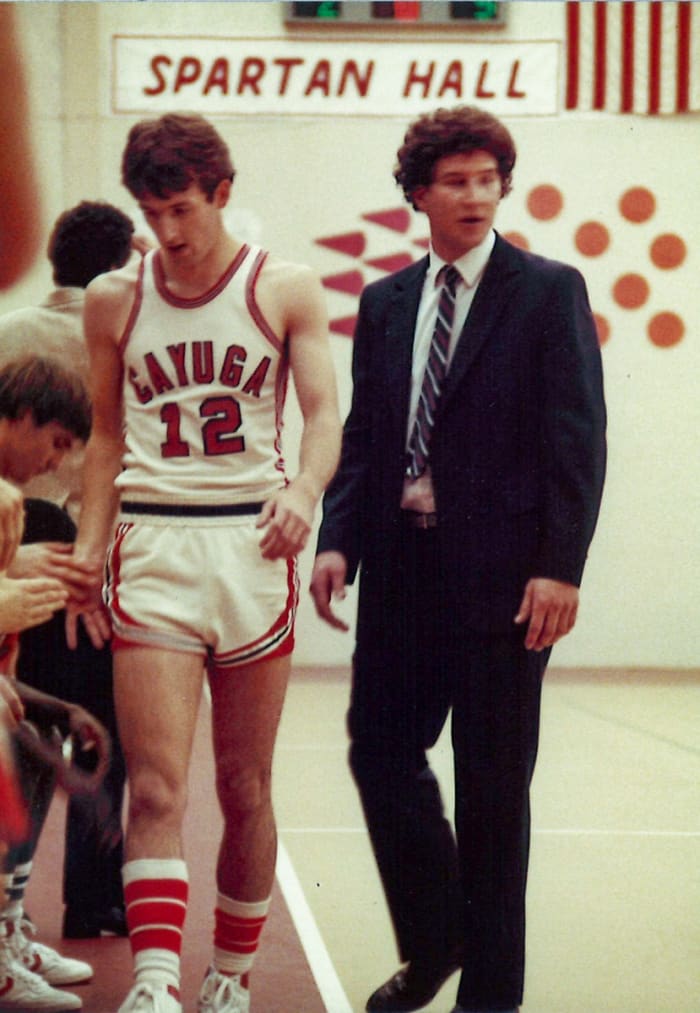
While Sankey (left) played basketball at Cayuga Community College, he further deepened his interest in coaching.
Courtesy of SEC Communications
What he encountered was an engineering class at 4 p.m. on Fridays, which brought home the realization that he really wasn’t into engineering. He had been pointed in that direction by his father, Jerry, and upon returning home that summer the conversation was unpleasant when Sankey told him he was changing majors and schools.
“I was in the garage at our house,” Sankey says. “I told him, ‘I’m going to change my major; I want to be a teacher and a coach.’ He never said no, to his credit. The quote I recall was, ‘You’re missing the boat.’”
Some 15 years later, Sankey brought his dad and brother Bill to the 1998 Final Four as his guests. His father told him then that his decision to leave engineering had worked out pretty well. That change led him back home to Cayuga Community College, where he was a hard-nosed sub for coach Jim Sigona, who was then just 23 years old. Sigona, now in his 35th year at Collin College in Texas, remains in contact with Sankey.
“He was an energy guy, a defender, who took a charge,” Sigona says. “He played hard and knew his role. He always had a great demeanor, whether he played five minutes or 20.”
Sankey’s first attraction to college athletics was reading John Wooden’s book, They Call Me Coach, which he won in a clean-desk competition at school at age 11. From that point forward, he was drawn to coaches and coaching. That was also the case at Cayuga, where he studied Sigona and his staff.
“He always wanted to sit by the coaches,” Sigona says. “He was always trying to listen to what we were saying. He was a great listener.”
After getting his undergrad degree at SUNY Cortland and going to grad school at Syracuse while simultaneously running the intramural program at then-Utica College, Sankey was perusing the classified ads in the weekly NCAA News looking for his next opportunity. He applied to several of them and received interest for an internship at Northwestern State in Natchitoches, La. He paid for his own plane ticket to get to the interview and was offered the job.
That led to a full-time job as the athletic department’s compliance director, tasked with keeping the Demons on the right side of the NCAA rules manual. And when the school parted ways with the coach of its woeful men’s golf team, Sankey volunteered for that gig, as well. He wasn’t a good golfer and knew very little about how to coach it. But he dived into the job, trying to build up the worst program in the Southland Conference. He gave every player a binder, asking them to chart every hole of every practice round. He went through all the binders and supplied feedback.
“He was determined,” says Scott Bergeron, Sankey’s first recruit. “He wanted to make the most out of a little golf team in Natchitoches, Louisiana.”
It wasn’t easy. The team had little in the way of equipment and had to drive an hour just to play an 18-hole course. Then, there were the uniforms. Northwestern State’s colors are purple and orange. Bergeron recalls the uniforms that were ordered coming in late, just before a trip to their first match. When they opened the boxes, they found lime-green shirts, white slacks and blue windbreakers. “He was just devastated,” Bergeron says.
The mode of transport was as bad as the uniforms, either piling in cars or sometimes getting the one of the athletic department’s two vans that was in a state of disrepair. Sankey recalls one trip from hell, when Northwestern State was headed from Natchitoches (pronounced “Naka-dish”) to Waco. They were in the van, on Louisiana Highway 6, and stopped for gas before dawn in the town of Many, La. Sankey somehow got locked in the convenience store while the rest of the team was outside, and the store employee was nowhere to be found. Later, when Coach and Team were back on the road, one of the players in the back told Sankey that they could see the road.
“Well, yeah,” Sankey replied.
“No, Coach,” the player said. “I can see the road through the floor of the van.”
Somehow, Northwestern State golf took a leap forward on Sankey’s watch. The Demons finished second in the Southland Conference in his final season, and Sankey won Coach of the Year honors. Shortly thereafter, he left the school to join the Southland as an assistant commissioner—but he still kept an eye on his former players.
Bergeron recalls the final hole of his final college tournament, the Southland championship. He came off the 18th green, and Sankey was standing there with his parents, ready to give him a hug.
“He’s a leader of men,” Bergeron says. “He cared about us. If my mom texts Greg right now, he’d return it right away.”
With a brain wired more for administration than coaching, Sankey’s career path was set when he went to the Southland. Within four years, he was named commissioner of the league while in his early 30s. And he soon began running himself ragged. Sankey was on his way to SEC headquarters for the first time in 1997, for a meeting in his role at the Southland. He never made it. While changing planes in Atlanta, Sankey went into the bathroom and passed out cold. Racing through life on minimal sleep, questionable diet and maximum caffeine, he had a “heart episode,” as he put it.
“When you’re waking up on the bathroom floor, you’re not in a good spot,” he says dryly. “After that, I went through about six months where I’d sit with people and ask how you balance life. I took notes.”
Of course he took notes. And made changes.
Sankey became an avid runner (he’s logged more than 40 marathons) and leaned into what he calls “leading a quiet life.” That includes more focus on family (he and his wife, Cathy, have two daughters; Hannah is a TV meteorologist and Moriah a teacher). But leading a quiet life doesn’t preclude having ambition. And when the SEC asked him to come aboard as an assistant commissioner, he jumped at it.
In late 2014, Mike Slive announced his retirement as SEC commissioner, effective in ’15. A man who combined jovial people skills with brass-knuckles effectiveness behind closed doors, Slive was leaving massive shoes to fill. Greg Sankey wanted the job, and many in the league wanted him to get it, but being the nuts-and-bolts guy in Slive’s shadow left him with a fairly obscure public persona.
Nevertheless, Sankey got enough backing to land an interview with the SEC committee appointed to pick a new commissioner at the Vanderbilt chancellor’s residence in Nashville in 2015. Thoroughly prepared as always, he thought he aced the interview—telling them, among other things, that more expansion was inevitable in college sports, and the SEC had to be ready for it.
The expectation was a quick resolution—Sankey could be told he had the job that very day, shortly after the interview. But time lagged for a while without any word, and Sankey began to get a sinking feeling that he wasn’t getting the promotion. He figured he had to leave the league and go find another job—but first he had to go make a presentation to the SEC presidents covering some league business.
“I started to go into a spiral,” he says. “You decide in those moments who you are. I had a job to do; I had some information to provide. I remember vividly grabbing my briefcase, straightening my tie and walking up the steps toward the door [to the meeting].
“One president stopped me and said, ‘Come with me.’ He took me into a room, sat me on the couch and said, ‘Congratulations.’ And the world just started spinning. Fast.”
Later that night, Sankey hugged Cathy and told her, “It worked.”
“What worked?” she asked.
“All of it,” he said.
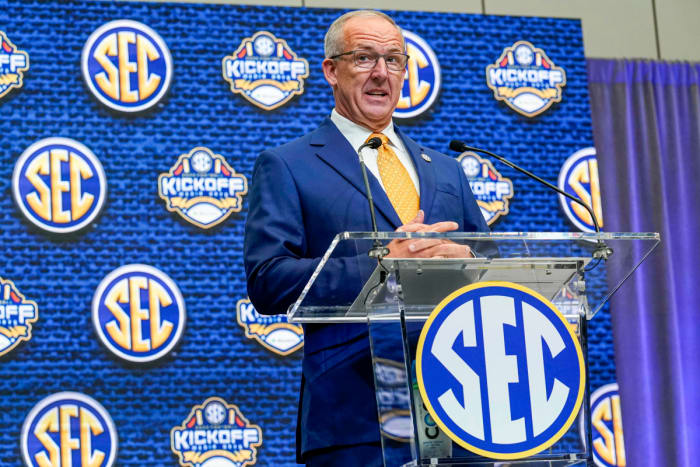
Sankey helped the SEC increase its revenue by $105 million in 2021 and reach a total of $833 million.
Dale Zanine/USA TODAY Sports
Can football be too big? Can it swallow everything else? Can the urge for more money and power turn America’s favorite sport into a destructive force for all other sports?
Sankey approaches the question the way he approaches most questions—mulling it, contemplating his answer, then phrasing it carefully. He’s sitting in a conference room at SEC headquarters in downtown Birmingham, temporarily relocating his workspace there during this summer while parts of the building are being renovated.
“I don’t spend a lot of time thinking about that,” he says in his deep, monotone voice. “We want it to be special and unique, and it is. We’re proud of what we’ve achieved in football.
“Can it be [too big]? You’d be a fool to say no; you’d be a fool to say yes.”
For three decades, the SEC has been at the forefront of the college football arms race. In a bigger-is-better society, no one has worked more relentlessly than the SEC to enlarge the sport’s place in it. Roy Kramer was the commissioner in the 1990s when the league added Arkansas and South Carolina and became the first conference to split into divisions and hold a championship game. Slive was next, adding Texas A&M and Missouri in 2012 and also serving as the driving force to establish a four-team playoff. Now it’s Sankey’s turn to be an agent of change and a champion of King Football.
In 2020, he set a prudent, patient but persistent course for playing sports amid the COVID-19 pandemic. If you poll college leaders about who was most important in saving the ’20 college football season, Sankey would be the landslide winner. “It was incredibly uncomfortable,” Sankey says. “It sucked, but I’m glad we did it.”
Then came Manifest Destiny. In 2021, he facilitated the upcoming SEC expansion to 16 teams, adding Texas and Oklahoma for arrival in ’25. (Or maybe ’24—stay tuned.) That news shocked the sport—no one more than then Big 12 commissioner Bob Bowlsby, who had been working closely with Sankey and others on the plan to expand the College Football Playoff. It was devastating news to him.
“I don’t think there’s any way to put a good face on being in the same room together for months on end and not being able to be forthright about what was going on,” Bowlsby says. “And yet, I understand why that wasn’t practical—I probably would have tried to get them to stay. I have to admit some deep disappointment that he and I didn’t have an earlier conversation. I feel the same way regarding the two athletic directors [at Texas and Oklahoma]. If you don’t have trust, it’s hard to have a friendship.”
He is one of the architects of a 12-team College Football Playoff model that encountered infuriating resistance for a year but now, as of last week, is on its way to becoming reality. And, last month, he told Sports Illustrated he is open to the possibility of expanding the NCAA basketball tournaments—an idea that may go beyond pushing the envelope, to actually tearing it.
The SEC’s additions of Texas and Oklahoma nearly crippled the Big 12, which lost its two most valuable brands. It also set off the massive reaction from the Big Ten this summer, which is bringing in USC and UCLA and similarly destabilizing the Pac-12. With two competing super conferences backed by two competing TV networks (the SEC and ESPN vs. the Big Ten and Fox), the arms race has reached a new level. And it’s likely not over.
“Sixteen provides a lot of scheduling options across the board in different sports. We’ve really focused on onboarding [Texas and Oklahoma], which is an enormous task,” Sankey says. “You also have to think about who adds value. Our view is we’re not just going to spend money to add teams to jump to a number. … I don’t think about numbers. I think 16 is healthy. No one is going to go to 17 and stay at 17. Eighteen is interesting to manage. Philosophically, we have distinguished ourselves as a brand, a big brand comprised of really big brands. Does that mean we’ll be at 16 forever? History suggests no, but I don’t just go to a number to say we’re going to a number.
“Every time we add, it’s an exponentially greater burden. It is a balance of scheduling decisions, finance, TV appearances. If you go to 20 and you have to air 10 games on a Saturday, that’s a challenge. You’re probably going to be cannibalizing your audience. Are you going pivot and play Thursday, Friday and Saturday football games? That has downstream impact. We continue to think about those things.”
The Darwinian consolidation in the pursuit of piles of cash has damaged the rest of the Power 5 conference structure and further frayed sports’ connective tissue of traditions, rivalries and geography. And while that is going on, Sankey is serving as the cochair of the NCAA Transformation Committee, tasked with helping steer this vast college athletic enterprise through times of tremendous upheaval.
Doing both at the same time makes for some interesting multitasking. College football has long lacked strong national leadership—and while Sankey is the best man for that job, he’s got another more localized job that pays his bills.
“First, you acknowledge reality,” Sankey says. “I’m the commissioner of the Southeastern Conference. No apologies for that, no apologies for how I’ve led and what we’ve accomplished. But I’ve had this life experience [working at multiple levels of college sports] that has a sensitivity to how we stay engaged broadly and recognize there are certain responsibilities and expectations that really require the need to adapt. That doesn’t mean we just kick people out [of NCAA Division I] … but we have to dig in to figure out how we go forward, given what’s expected of us.
“I think it’s good for the broader fan base of college football that, uniquely, we’ve restored rivalries. It’s not simply Texas and Texas A&M; it’s Texas and Arkansas. You maintain the Texas and Oklahoma rivalry. … We’ve added big brands—the notion of Texas playing Alabama this fall and repeating that [when both are in the SEC], I think that magnifies interest. … It’s good for us. I think it sets us up in a healthy way in the future and it can build interest in college football.
“You just have a responsibility when that opportunity presents itself. I have enormous respect for Bob Bowlsby, and you just hate those personal impacts. I know it has an impact on the remainder of the Big 12, but they made a quick pivot and have an opportunity to move forward in a healthy way.”
That SEC expansion also had an impact on league member Texas A&M, which fled the Big 12 a decade ago in no small part because it was tired of the imperious attitude of rival Texas. When news of the Longhorns and Sooners coming aboard broke last July, it caught the Aggies by unpleasant surprise and thrust Sankey into damage repair mode.
“I was with him [at SEC football media days],” says A&M athletic director Ross Bjork. “He was definitely caught off-guard about how that news broke. He admitted, ‘Hey, look, I could have had a better communication plan with A&M, but it happened faster than I anticipated.’ He admitted that, and to me that’s what good leaders do. They own situations; they own responsibility. He owned a lot of things.

Sankey is in his eighth year as SEC Commissioner after taking over the post on June 1, 2015.
Courtesy of SEC Communications
“Do we like how it happened? No. We talked through that. The final outcome was probably inevitable, anyway. The nature of college sports is changing, so let’s be on the forefront of it.”
Says Sankey: “It created some difficulty originally, but I appreciate that we had a unanimous vote to extend the invitations.”
(One apparent concession to A&M not standing in the way of Texas’s arrival in the league: Bjork says the first football game in the resumption of the Longhorns-Aggies rivalry will be in College Station, not Austin.)
Other than the expansion imbroglio, Bjork has effusive praise for Sankey’s leadership. “The respect he has among presidents, chancellors, ADs, he’s at the pinnacle for commissioners,” he says. That admiration is echoed throughout the league, from athletes to coaches to administrators.
“His intellect is truly impressive, and his ability to think ahead and prepare for issues before they become issues is tremendous,” says Missouri president Mun Choi. “I’m so glad he’s our commissioner.”
Even in private conversation, it is impossible to find a Sankey detractor in the SEC. That matters to the commissioner. He has forcefully discouraged the league’s leaders from being anonymous media sources, and among his strongest dislikes are anonymous criticisms of the SEC from peer conferences.
He listed “the anonymous Power 5 AD commenting about us,” and “the anonymous Power 5 conference official commenting about us,” among his top-five pet peeves.
“What you don’t see, even now, is a return of some of that commentary that was directed at us last year,” Sankey says. “I’m really proud of our campuses, that they don’t feel the need to engage in the diminishment of others to elevate ourselves.”
As for the Big Ten expansion? Without drawing a direct comparison, Sankey has pointed out the 16-team SEC will remain an affiliation of schools in contiguous states. And he has stressed the historic rivalries that will be revived. That’s as far as he’s willing to go toward critiquing USC and UCLA joining a league full of relative strangers thousands of miles away.
“We’ve really focused on how we make decisions and respect how others make decisions,” Sankey says. “I recognize that the reality is, things change. I’m confident our Big Ten colleagues engaged in their due diligence and decision-making, and they have the freedom to do so. That’s where I leave it. Should they, shouldn’t they—that’s not up to me.”
So much is up to Greg Sankey, though. From the size of the playoff to the shape of the NCAA to the SEC’s giant role in the race for more revenue, he is arguably more involved in what’s to come than anyone. The enterprise putatively is in good hands— Sankey’s hands—unless he drops it and breaks it while reaching for more cash.
Watch college football live with fuboTV: Start a free trial today!
More College Football Coverage:
• Dellenger: LSU’s Brian Kelly Era Begins With a Thud
• Forde-Yard Dash: These Teams May Need an Early Breakup
• Johnson: Post–Week 1 Bowl Projections for Playoff, NY6
